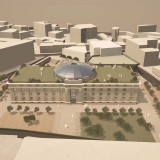Supervisor:
2024
The area we have chosen to focus on is the city of Agrinio, which until a few years ago was directly linked to tobacco production, influencing the daily lives of its inhabitants. Although in the 19th century tobacco cultivation was at its peak, today this connection has been lost, a fact that has cost the region dearly. Many times, citizens and local authorities have expressed the need to preserve and highlight this historical heritage. In this context, we thought of proceeding with the creation of a tobacco museum within the city of Agrinio, which would offer the visitor a comprehensive and immersive experience, describing in detail — through the exhibits — the different stages of tobacco production and processing. To house our proposal, we considered the reuse of one of the buildings that were used as tobacco warehouses, which are no longer utilized, are in poor condition due to lack of maintenance, and are directly linked to the historical heritage of Agrinio. We settled on the Papapetrou Tobacco Warehouses, a building that is in a good location, near the city center on Mavili and Kostis Palamas streets, and presents architectural interest. It is an emblematic building that, however, has been left vulnerable to weather conditions without being used. Due to its size, it offers the possibility to accommodate other cultural spaces and infrastructures that the city lacks.
Additionally, in Agrinio, the issue of the absence of an adequate library is currently being raised, as the existing one is not enough to meet the needs of the residents, as well as the lack of public and free cultural spaces.
In the first chapter of this project, we will deal with the historical analysis of the city of Agrinio and its close relationship with tobacco cultivation, from the "golden age" of tobacco in the 19th century to its cessation after the German occupation. Furthermore, the stages of tobacco cultivation and processing will be briefly analyzed, from the stage of sowing to the production of cigarettes in modern factories. Finally, a brief study of the architecture of the tobacco warehouses, buildings used for the storage and processing of tobacco products, will be conducted.
In the second chapter, we will describe and analyze in detail the current condition of the Papapetrou Tobacco Warehouses, emphasizing its history as well as its technical description.
In the third chapter, we present our proposal for the restoration and reuse of the Papapetrou Tobacco Warehouses with the aim of creating a Tobacco Museum and Cultural Center in the city.







